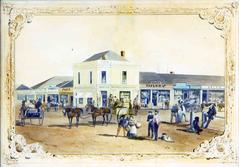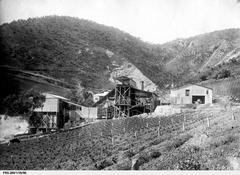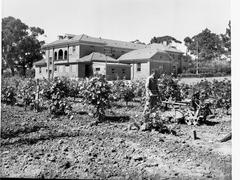Guide to Visiting Sturt Gorge Recreation Park, Adelaide, Australia
Date: 25/07/2024
Introduction
Welcome to Sturt Gorge Recreation Park, a unique blend of geological, historical, and ecological significance located just 13 kilometers south of Adelaide’s central business district. This comprehensive guide explores the park’s rich geological formations, historical background, visitor information, and activities that make it a must-visit destination for nature enthusiasts, families, and adventure seekers.
Sturt Gorge Recreation Park is internationally renowned for its geological importance, particularly due to the Sturt Tillite formation. This formation provides definitive evidence of Cryogenian glaciation, also known as the “Snowball Earth” hypothesis, dating back approximately 800 million years. The park was officially established in 1973 to protect these unique geological features and diverse ecosystems (source).
Before European settlement, the area was inhabited by the Kaurna Aboriginal people, whose cultural heritage remains an integral part of the park’s history. Since European settlement, activities like grazing, logging, and mining have altered the landscape. However, recent conservation efforts have focused on restoring native habitats and protecting the park’s biodiversity (source).
In recent years, Sturt Gorge has seen significant developments aimed at both conservation and recreation. The addition of Craigburn Farm has increased the park’s area considerably, transforming it into a major site for revegetation and a destination for mountain biking and hiking. The park now boasts a high-class network of trails, offering visitors the opportunity to observe its oldest rocks, grasslands, and open woodlands (source).
Table of Contents
- Introduction
- Geological Importance
- Establishment and Conservation Efforts
- Indigenous Heritage
- European Settlement and Land Use Changes
- Modern Conservation and Recreation
- Flora and Fauna
- Visitor Information
- Nearby Attractions
- Special Events and Tours
- Photographic Spots
- Fire Management and Safety
- Recreational Activities
- Community Involvement
- FAQ
- Conclusion
- References
Geological Importance
Sturt Gorge Recreation Park is renowned for its geological significance, particularly due to the presence of the Sturt Tillite formation. This formation was the first in the world to provide definitive evidence of Cryogenian glaciation, also known as the “Snowball Earth” hypothesis. The Sturt Tillite is believed to have been formed from glacial material that dropped from ice floating in an ocean that covered the area approximately 800 million years ago. This discovery has made the park an internationally recognized site for geological research and education.
Establishment and Conservation Efforts
The park was officially established in 1973 to protect its unique geological features and diverse ecosystems. It is classified as an IUCN Category III protected area, which designates it as a natural monument or feature of significant importance. In 1980, the park was listed on the former Register of the National Estate, further emphasizing its conservation value.
Indigenous Heritage
Before European settlement, the area now known as Sturt Gorge Recreation Park was inhabited by the Kaurna Aboriginal people. The Kaurna people have a deep connection to the land, and their cultural heritage is an integral part of the park’s history. The park’s management acknowledges the ongoing role of Aboriginal peoples in caring for their Country, including in parks across South Australia.
European Settlement and Land Use Changes
Since European settlement, the native vegetation in the area has undergone extensive modifications due to activities such as grazing, logging, and mining. These activities significantly altered the landscape and ecosystems of the region. However, recent conservation efforts have focused on restoring native habitats and protecting the park’s biodiversity.
Modern Conservation and Recreation
In recent years, the park has seen significant developments aimed at both conservation and recreation. The addition of Craigburn Farm has increased the park’s area considerably, transforming it into a major site for revegetation and a destination for mountain biking and hiking. The park now boasts a high-class network of new trails, offering visitors the opportunity to observe the oldest rocks in the park and their surrounding grasslands and open woodlands.
Flora and Fauna
Sturt Gorge Recreation Park is home to numerous rare plants and a wide range of habitats, including grasslands, grey box grassy woodlands, blue gum woodlands, and ancient river red gums. These habitats are crucial remnants of the original environment that once thrived in this area, providing sanctuary and sustenance for a multitude of native animals. The park’s diverse ecosystems support species such as koalas, kangaroos, short-beaked echidnas, kookaburras, yellow-tailed black cockatoos, and Adelaide rosellas.
Visitor Information
Visiting Hours and Tickets
Sturt Gorge Recreation Park is open to visitors every day from sunrise to sunset. There are no entrance fees, making it an accessible destination for everyone. However, always check for any park advisories or closures before planning your visit.
Accessibility
The park is accessible from various pedestrian entry points around its perimeter. Assistance dogs are permitted in the park, provided they are appropriately restrained on a lead and remain under effective control at all times.
Travel Tips
Visitors are encouraged to download park maps from the National Parks and Wildlife Service SA website or use the Avenza Maps app for real-time navigation within the park. Always carry sufficient water, wear appropriate footwear, and be prepared for changing weather conditions.
Nearby Attractions
While visiting Sturt Gorge Recreation Park, consider exploring nearby attractions such as the Belair National Park, Cleland Conservation Park, and Adelaide’s vibrant city center. Each location offers unique experiences and further opportunities to connect with nature.
Special Events and Tours
The park offers various opportunities for visitors to engage with its rich history and natural beauty. Educational programs and guided tours are available to help visitors understand the park’s geological and ecological significance. Additionally, the park’s management encourages visitors to respect the natural environment by not touching or removing anything and by taking all rubbish with them when they leave.
Photographic Spots
Sturt Gorge Recreation Park is a photographer’s paradise, with numerous scenic spots perfect for capturing the natural beauty of the area. Popular photographic spots include the cascading waterfalls, rockpools, and the diverse flora and fauna.
Fire Management and Safety
Given the park’s location and natural features, fire management is a critical aspect of its conservation strategy. Fires of any kind are prohibited within the park to protect its delicate ecosystems. The park is closed on days of Catastrophic Fire Danger and may also be closed on days of Extreme Fire Danger. Visitors are advised to check the current fire danger rating before planning their visit.
Recreational Activities
Sturt Gorge Recreation Park offers a variety of recreational activities that allow visitors to explore its natural beauty while promoting conservation awareness. The park features a large network of shared-use mountain bike and walking trails, cascading waterfalls, rockpools, and creeks that flow during winter. Popular trails include the Magpie Creek Trail, which leads to a mini waterfall after rain, and the Lakeview Trail in the Craigburn Farm section of the park.
Community Involvement
Community involvement plays a significant role in the park’s conservation efforts. Volunteer programs and Friends of Parks groups offer opportunities for individuals to participate in activities such as working bees, training, and other events aimed at preserving the park’s natural environment. The Million Trees Program is one such initiative that encourages community participation in tree planting and habitat restoration projects.
FAQ
What are the visiting hours for Sturt Gorge Recreation Park? The park is open every day from sunrise to sunset.
Are there any entrance fees? No, there are no entrance fees for visiting the park.
Is the park accessible for visitors with disabilities? Yes, the park is accessible, and assistance dogs are permitted.
Are there guided tours available? Yes, educational programs and guided tours are available.
What should I bring when visiting the park? Carry sufficient water, wear appropriate footwear, and be prepared for changing weather conditions.
Conclusion
Sturt Gorge Recreation Park is a site of immense historical, geological, and ecological significance. Its unique features, rich biodiversity, and cultural heritage make it a valuable natural asset. Through ongoing conservation efforts and community involvement, the park continues to thrive as a sanctuary for native flora and fauna while offering visitors a chance to connect with nature and learn about the region’s fascinating history.
Visitors to Sturt Gorge can enjoy a variety of activities, from hiking and mountain biking to bird watching and picnicking. The park’s diverse habitats support a multitude of native animals and rare plants, making it an excellent destination for nature lovers and photographers. Accessibility and sustainable tourism practices ensure that everyone can experience the park’s beauty while preserving its natural environment for future generations (source).
As urban encroachment and climate change present ongoing challenges, continuous adaptation and proactive measures are essential to maintain the park’s ecological integrity. The collaborative efforts of the South Australian government, local communities, and dedicated volunteers play a crucial role in ensuring the park’s preservation and sustainable use.
For more information and to plan your visit, download the Audiala mobile app, check out related posts on our website, or follow us on social media.











